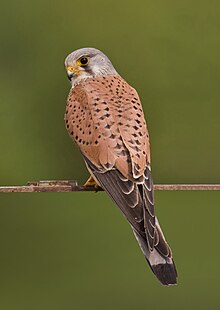Australaves
| Australaves | |
|---|---|

| |
| Kestrel, Falco tinnunculus | |
| Scientific classification | |
| Domain: | Eukaryota |
| Kingdom: | Animalia |
| Phylum: | Chordata |
| Class: | Aves |
| Clade: | Telluraves |
| Clade: | Australaves Ericson, 2012 |
| Clades | |
Australaves[1] is a recently defined[2] clade of birds, consisting of the Eufalconimorphae (passerines, parrots and falcons) as well as the Cariamiformes (including seriemas and the extinct "terror birds").[3] They appear to be the sister group of Afroaves.[3] As in the case of Afroaves, the most basal clades have predatory extant members, suggesting this was the ancestral lifestyle;[4] however, some researchers like Darren Naish are skeptical of this assessment, since some extinct representatives such as the herbivorous Strigogyps led other lifestyles.[5] Basal parrots and falcons are at any rate vaguely crow-like and probably omnivorous.[6]
| Australaves |
| ||||||||||||||||||
Cladogram of Telluraves relationships based on Prum, R.O. et al. (2015).[3]
References
- ^ Kimball RT, Wang N, Heimer-McGinn V, Ferguson C, Braun EL (2013). "Identifying localized biases in large datasets: A case study using the Avian Tree of Life". Molecular Phylogenetics and Evolution. 69 (3). Mol Phylogenet Evol: 1021–1032. doi:10.1016/j.ympev.2013.05.029. PMID 23791948.
- ^ Ericson, P. G. (2012). "Evolution of terrestrial birds in three continents: biogeography and parallel radiations". Journal of Biogeography. 39 (5): 813–824. doi:10.1111/j.1365-2699.2011.02650.x.
- ^ a b c Prum, R.O. et al. (2015) A comprehensive phylogeny of birds (Aves) using targeted next-generation DNA sequencing. Nature 526, 569–573.
- ^ Jarvis, E. D.; Mirarab, S.; Aberer, A. J.; Li, B.; Houde, P.; Li, C.; Ho, S. Y. W.; Faircloth, B. C.; Nabholz, B.; Howard, J. T.; Suh, A.; Weber, C. C.; Da Fonseca, R. R.; Li, J.; Zhang, F.; Li, H.; Zhou, L.; Narula, N.; Liu, L.; Ganapathy, G.; Boussau, B.; Bayzid, M. S.; Zavidovych, V.; Subramanian, S.; Gabaldon, T.; Capella-Gutierrez, S.; Huerta-Cepas, J.; Rekepalli, B.; Munch, K.; et al. (2014). "Whole-genome analyses resolve early branches in the tree of life of modern birds" (PDF). Science. 346 (6215): 1320–1331. doi:10.1126/science.1253451. PMC 4405904. PMID 25504713. Archived from the original (PDF) on 2015-02-24. Retrieved 2015-08-29.
- ^ Mayr, G. & Ritchter, G. (2011) Exceptionally preserved plant parenchyma in the digestive tract indicates a herbivorous diet in the Middle Eocene bird Strigogyps sapea (Ameghinornithidae). Paläontologische Zeitschrift, Volume 85, Issue 3, pp 303–307.
- ^ L. D. Martin. 2010. Paleogene avifauna of the holarctic. Vertebrata PalAsiatica 48:367-374

